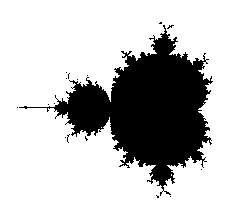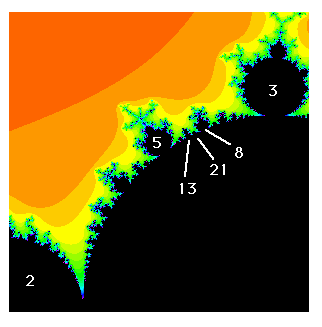
First we re-examine Fibonacci's original Rabbit problem and see how it can generate an infinite sequence of two symbols and in a later section we see how the same sequence is very simply related to Phi also.
Month 0: NNext month, the pair become Mature, denoted by "M".
Month 0: 1: N MThe following month, the M becomes "MN" since they have produced a new pair (and the original pair also survives).
Month 0: 1: 2: N M M NThe M of month 2 become MN again and the N of month 2 has become M, so month 3 is: "MNM"
Month 0: 1: 2: 3: N - M - M - M \ \ N N - MThe next month it is "MNMMN".
The general rule is
We have now got a collection of sequences of M's and N's which begins:

0: N =N 1: M =M 2: M N =MN 3: M N M =MNM 4: M N M M N =MNMMN 5: MNM MN MNM =MNMMNMNM ... ...Compare this with the picture we had of the Rabbit Family Tree where sometimes M is replaced by NM and sometimes by MN.
We often use 1s and 0s for
this sequence, so here we have replaced M by 1 and N by 0:
From this definition we can
see that
each monthly sequence
is the start of the following month's sequence.
This means that (after the first sequence which begins with N), there is really just one infinitely long sequence, which we call the rabbit sequence or the golden sequence or the golden string.
1011010110
1101011010 1101101011 0110101101 0110110101
1011010110
1011011010 1101011011 0101101101 0110101101
1010110110
1011010110 1101011010 1101101011 0110101101
0110110101
1010110110 1011011010 1101011011 0101101101
0110101101
1010110101 1011010110 1101011010 1101101011
0101101101
0110110101 1010110110 1011011010 1101011011
0101101011
0110101101 1010110101 1011010110 1101011010
1101101011
0101101101 0110110101 1010110110 1011010110
1101011011
0101101011 0110101101 1010110101 1011010110
1011011010
1101101011 0101101101 0110101101 1010110110
1011010110
1101011011 0101101011 0110101101 0110110101
1011010110
1011011010 1101101011 0101101101 0110101101
1010110110
1011010110 1101011010 1101101011 0110101101
0110110101
1011010110 1011011010 1101011011 0101101101
0110101101
1010110110 1011010110 1101011010 1101101011
0110101101
0110110101 1010110110 1011011010 1101011011
0101101101
0110101101 1010110101 1011010110 1101011010
1101101011
0101101101 0110110101 1010110110 1011011010
1101011011
0101101011 0110101101 1010110101 1011010110
1101011010
1101101011 0101101101 0110110101 1010110110
1011010110
1101011011 0101101011 0110101101 1010110101
1011010110
1011011010 1101101011 0101101101 0110110101
1010110110
1011010110 1101011011 0101101011 0110101101
0110110101
1011010110 1011011010 1101101011 0101101101
0110101101
1010110110 1011010110 1101011010 1101101011
0110101101
0110110101 1011010110 1011011010 1101011011
0101101101
0110101101 1010110110 1011010110 1101011010
1101101011
0110101101 0110110101 1010110110 1011011010
1101011011
0101101101 0110101101 1010110101 1011010110
1101011010
1101101011 0101101101 0110110101 1010110110 2000
Our golden string contains copies of itself inside it. To see this we first show another way in which we can write down the golden string.
Combining this with the fact that each time we replace all the letters and get a new string, the fact that the old string is the start of the new string, then we have the following simple method of generating the golden sequence (we use 1 for M and 0 for N so that it gives the list of bits above):
10 ^ We are pointing at 0, so write a 1 at the end, 101 ^ and move the left hand on one place on (to point to the new symbol in fact): 101 ^ We are pointing at a 1, so write 10 at the end 10110 ^ and move the left hand on one place: 10110 ^ We are pointing at a 1 so write 10 at the end 1011010 ^ and move the left hand on one place: 1011010 ... ^Here is the algorithm
Start with sequence 10, pointing at the 0. (Step 1) if pointing at 0 then write 1 on to the end of the sequence; OR if pointing at 1 then write 10 at the end; (Step 2) Now point at the next symbol along (Step 3) Start again at step 1.and below it is shown as an animated gif image:

The Mandelbrot set shown here has been written about often in maths books, appears in magazines and posters, greeting cards and wrapping paper and in lots of places on the Net.

A detail from the Mandelbrot set picture is shown here. It is also a link to a page on how the Fibonacci numbers occur in the Mandelbrot Set (at Boston University Mathematics Department).